 Magnetic vortices have been made and seen in a crystal with a special structure.
Magnetic vortices have been made and seen in a crystal with a special structure.
Thursday, March 26, 2020
Skyrmions seen in a kagome lattice
 Magnetic vortices have been made and seen in a crystal with a special structure.
Magnetic vortices have been made and seen in a crystal with a special structure.
Just add salt to enhance the spatial resolution of single-molecule Raman spectroscopy
 A thin substrate of sodium chloride aids the spectroscopic resolution of single-molecule vibrations.
A thin substrate of sodium chloride aids the spectroscopic resolution of single-molecule vibrations.
Quantum phenomenon governs organic solar cells
 Vibronic coherence contributes to photocurrent generation in organic semiconductor heterojunction diodes.
Vibronic coherence contributes to photocurrent generation in organic semiconductor heterojunction diodes.
Upgrading biomass with selective surface-modified catalysts
 Scientists demonstrated how the conversion of a plant derivative into fuels and other valuable chemicals can be achieved by loading single atoms of platinum onto titanium dioxide.
Scientists demonstrated how the conversion of a plant derivative into fuels and other valuable chemicals can be achieved by loading single atoms of platinum onto titanium dioxide.
Experiments in mice and human cells shed light on best way to deliver nanoparticle therapy for cancer
 Researchers in the cancer nanomedicine community debate whether use nanoparticles can best deliver drug therapy to tumors passively. Now, new research on human and mouse tumors in mice suggests the question is even more complicated.
Researchers in the cancer nanomedicine community debate whether use nanoparticles can best deliver drug therapy to tumors passively. Now, new research on human and mouse tumors in mice suggests the question is even more complicated.
'Native oxide' allows controllable thinning of two-dimensional materials
 An international team of researchers show how to take advantage of the natural interaction of 2D materials with air to reduce their thickness with (sub-)monolayer precision.
An international team of researchers show how to take advantage of the natural interaction of 2D materials with air to reduce their thickness with (sub-)monolayer precision.
As electronics shrink to nanoscale, will they still be good as gold?
 Engineers wonder whether this tried and true precious metal, found in the bowels of most electronic devices, can stand up to the strain of next-generation data processing.
Engineers wonder whether this tried and true precious metal, found in the bowels of most electronic devices, can stand up to the strain of next-generation data processing.
Artificial intelligence identifies optimal material formula
 One algorithm replaces countless time-consuming experiments.
One algorithm replaces countless time-consuming experiments.
Innovative thinner electrolyte can improve functioning of solid oxide fuel cells
 Scientists have synthesized a new thin film that could make energy production more efficient and cleaner.
Scientists have synthesized a new thin film that could make energy production more efficient and cleaner.
Novel hybrid nanocomposite sheds light on therapy of deep-seated orthotopic lung tumors
 The nanocomposite was developed through the assembly of gold nanobipyramids on black phosphorus nanosheets. This nanocomposite could simultaneously enhance singlet oxygen generation and hyperthermia by localized surface plasmon resonance in cancer therapy.
The nanocomposite was developed through the assembly of gold nanobipyramids on black phosphorus nanosheets. This nanocomposite could simultaneously enhance singlet oxygen generation and hyperthermia by localized surface plasmon resonance in cancer therapy.
Subscribe to:
Comments (Atom)
